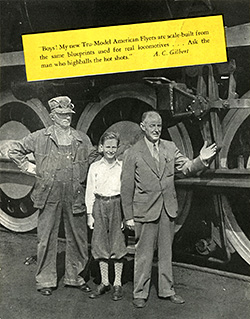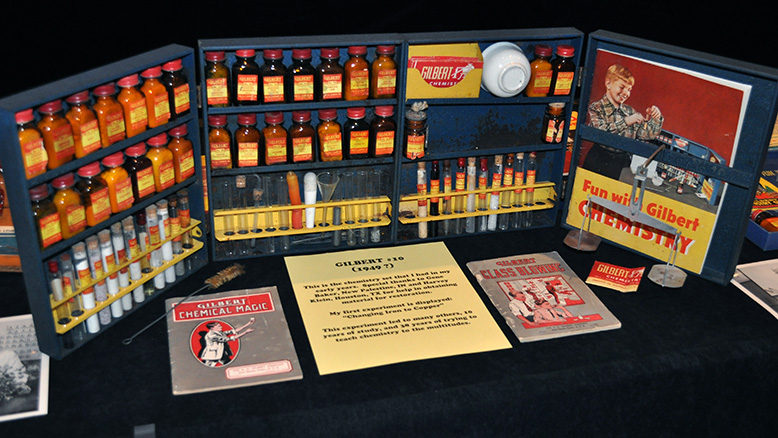- 2023 National Convention Videos
2023 ACGHS Convention – Part 1: Reminiscences (30:12)
A. C. Gilbert’s office at Erector Square, July 20, 2023, featuring reminiscences by David Gilbert, David Conte, Greta Edelman, Ronda Aurigemma, Tim Egan, Sev Marsted, [John O’Connor?], Judith Petrulis, Cynthia Potts and her sister, Dr. Janice Papeika Thibodeau, Kevin Wetmore, and Charles Zambrano. Audio quality varies from reasonably good to unintelligible.
2023 ACGHS Convention – Part 2: Convention Floor (8:44)
July 22, 2023, at the Ballroom of the Best Western Plus North Haven, featuring the tables of David & Kathy Gilbert, Bob Asleson, Frank Merrill, William Vanderbeek, Ken Schuman, Joe Grobmeyer, Andy & Cathy Jugle, Bill Pike, Ludwig Spinelli, Ken Weinig, Chuck Bisek, Greg Bilek, Tom Lindsey, Robert Hohne, Stephen Amato, the Connecticut S Gaugers, Bill & Karna Tanis, the You Build It Table, and Greg Bilek’s “Gilbert Erector” game.
Continue reading → - 1939: A Snapshot of American Flyer
Above: Cover of the 1939 American Flyer catalog
Although best remembered for the S gauge trains of the 1950s that it made as a division of the A. C. Gilbert Company, American Flyer was initially an independent company whose origins date back nearly a half century earlier. Chicago, Illinois-based toymaker William Frederick Hafner developed a clockwork motor for toy cars in 1901 while working for a company called Toy Auto Company. According to the recollections of William Hafner’s son, John, he had developed a clockwork train running on O gauge track by 1905.
In December, 1937, the A.C. Gilbert Company acquired American (Chicago) Flyer. Gilbert soon moved manufacturing from Chicago to New Haven, Connecticut, and re-designed parts of the product line. The initial changes included substitution of the ‘slot & tab’ couplers with link and pin semi-automatic ones on the higher priced 10-inch freight cars and steam engine tenders.
The smaller scale (1:64) models became much more prominent with its introduction in the 1939 catalog, which featured World’s Fair imagery on the yellow, black, and white cover. The relatively expensive, heavy, and highly detailed engines and cars had had diecast zinc alloy bodies. The 1939 catalog also featured the following introduction by A.C. Gilbert:
Hello Boys!
The Gilbert Hall of Science now brings you trains so true to life you can almost smell hot grease.
15 new features to give miniature railroading breath-taking realism.
Boys, if you went to the New York World’s Fair, you probably saw these marvelous new American Flyer Trains in action. Day after day vast crowds of boys – Dads – and Veteran railroad men gathered around to see . . . hear . . . and applaud these Tru-Model Trains of Tomorrow – that are here today.
Here, indeed, are the latest and most up-to-date “Challengers of the High Iron” . . . trains that capture all the romance of railroading . . . its air and adventure . . . its soul-stirring sounds . . . its sense of mighty power that you can control with a finger.
American Flyer engineers and technicians of the Gilbert Hall of Science have combined their inventive genius to develop 15 sensational new features. These features make electric trains look more realistic . . . sound more realistic – and operate in a more realistic way than ever before was dreamed possible.
Be sure to read every word in this booklet. That will help you decide what set and equipment you want for Christmas. Then see them at your local store. Take Dad along. He will be just as eager for an American Flyer as you. Tell your Uncles, Aunts, Grandparents what equipment you would like, so they can all join in giving you an American Flyer Merry Christmas.
Signed A.C. Gilbert
President The A.C. Gilbert Co.
and Founder of the Gilbert Hall of Science After WWII, the 3/16s scale O gauge trains were re-engineered to run on much more realistic two rail track. The fine detail of the diecast engines, tenders, and cars that had debuted in the ‘39 catalog reappeared. The engines and tenders continued to be made of diecast metal, but the cars’ bodies were made out of plastic. Because of the relatively accurate scale of the rolling stock and two rail track, these trains (not yet referred to as “S” gauge by Gilbert) were significantly more realistic than their 3 rail O gauge counterparts.
After WWII, the 3/16s scale O gauge trains were re-engineered to run on much more realistic two rail track. The fine detail of the diecast engines, tenders, and cars that had debuted in the ‘39 catalog reappeared. The engines and tenders continued to be made of diecast metal, but the cars’ bodies were made out of plastic. Because of the relatively accurate scale of the rolling stock and two rail track, these trains (not yet referred to as “S” gauge by Gilbert) were significantly more realistic than their 3 rail O gauge counterparts.Photograph on right from page 2 of the 1939 catalog, showing John Kane, engineer of New Haven’s Crack Trains, with Mr. Gilbert and “Len” Bennett. (Click on photo to enlarge)
Continue reading →

